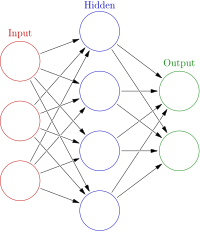
Photo from wikipedia
Landslide susceptibility maps can be developed with artificial neural networks (ANNs). In order to train our ANNs, a digital elevation model (DEM) and a scar map of one previous event… Click to show full abstract
Landslide susceptibility maps can be developed with artificial neural networks (ANNs). In order to train our ANNs, a digital elevation model (DEM) and a scar map of one previous event were used. Eleven attributes are generated, possibly containing redundant information. Our base model is formed by, essentially, one input (the DEM), eleven attributes, 30 neurons, and one output (susceptibility). Principal components (PCs) group information in the first projected variables, the last ones can be expendable. In the present paper, four groups of models were trained: one with eleven attributes generated from the DEM; one with 8 out of 11 attributes, in which 3 were eliminated by their high correlation with others; other, with the data projected over its PCs; and another, using 8 out of 11 PCs. The used number of neurons in hidden layer is 30, calibrated based on a complexity analysis that is an in-house developed method. The ANN models trained with the original data generated better statistical results than their counterparts trained with the PC transformed input. Keeping the original 11 attributes calculated provided the best metrics among all models, showing that eliminating attributes also eliminates information used by the model. Using 11 PC transformed attributes hindered trained. However, for the model with eight PCs, training was much faster than its counterpart with little accuracy loss. The metrics and maps achieved were considered acceptable, conveying the power of our model based on ANNs, which uses essentially one input (the DEM) for mapping areas susceptible to mass movements.
Journal Title: Environmental Monitoring and Assessment
Year Published: 2020
Link to full text (if available)
Share on Social Media: Sign Up to like & get
recommendations!